by Jessica Giles | May 8, 2023
Florida’s Iconic Tupelo Honey is in a Sticky Situation. Can Beekeepers Bring it Back?
A trip to the banks of the Apalachicola River, where Tupelo honey once flourished, reveals why this Florida icon isn’t flowing like it once did.

Early morning sunlight filters through the clouds on this crisp February day as I roll west down Florida State Road 71 in Gulf County, the heart of Florida’s Panhandle. Van Morrison croons through the speakers with one of his classics: “She’s as sweet as tupelo honey / Just like honey baby, from the bee.”
Outside the car window, fields of cotton flash by, along with stretches of what once was pine forest—the treetops snapped off like pretzel sticks during Hurricane Michael. The jagged trunks stand as evidence of the carnage, leaning like dominoes frozen mid-fall.
Passing roadway signs hint that I’m getting close to my destination. “Welcome to the City of Wewahitchka. Home of the Dead Lakes & Tupelo Honey.” I’ve driven five hours from my home in Jacksonville to Wewa, as the locals call it, in search of a golden Florida icon that has inspired legendary songs and Oscar-nominated films with its sweet nectar and the reason it’s not flowing like it once was here in the Sunshine State.
They say that true tupelo honey is unmistakable. Hold a bottle up to the sunlight and the pale amber liquid’s subtle green hue reveals itself. Bring it to your nose, and you’ll inhale the sweet aroma of citrus and vanilla. If it crystallizes, it’s crap. But the true test comes when you slip a spoonful into your mouth. Seasoned tupelo tasters will know right away if it’s a fraud.
Although they can’t all seem to agree on what it tastes like—buttery, citrusy, floral, maybe a hint of cinnamon—they know decisively what it’s not. And the producers of this coveted honey are quick to point out the heap of phonies on the shelves. The true tupelo harvesters are few and far between—and they like to live a little off-the-grid.
Tupelo trees like “wet feet,” and they flourish here along the banks of the Apalachicola River and the Dead Lakes—when they’re not getting pummeled by a Cat. 5 ’cane. Since tupelo honey is such a rarity, it can feel like the world revolves around this sticky delicacy in these parts. Businesses such as the Honey Hole Restaurant and Hive & Home Construction hint at how integral this product is to the personality of the region. And the beekeepers who harvest it? Well, they’re personalities themselves.
A Family Affair
As I pull into the dirt driveway of L. L. Lanier & Son’s Tupelo Honey, Glynnis Lanier is coming down the steps of the old homestead with her husband, Ben, on her heels. Their 19-year-old son Heath hangs in the doorway, hoping the frame might shield him from my questions. Ben seems to have dressed up for the occasion, his collared baby-blue button-up tucked neatly into his blue jeans. His warm greeting drips with the kind of Southern drawl that makes every sentence feel slow, even when it’s delivered with the cadence of an auctioneer. He asks me where I’m from, and then he points to the white-framed window just behind his shoulder.
“My daddy was born right there in that house,” he says.
The Lanier family is a legend in the tupelo industry. Ben’s great-great-grandfather started the business back in 1898, and now 125 years later, the Laniers are still beekeeping and bottling out of the same honey house. Ben and Glynnis even consulted on the film Ulee’s Gold to help director Victor Nunez make the beekeeping as accurate as possible. All of the swampland and bee yards in the movie? Those belong to the Laniers. The trio have amassed a customer base that spans the globe. In fact, while we chat in the front yard, a couple with Canadian plates pulls into the driveway looking for the famed Lanier tupelo honey.
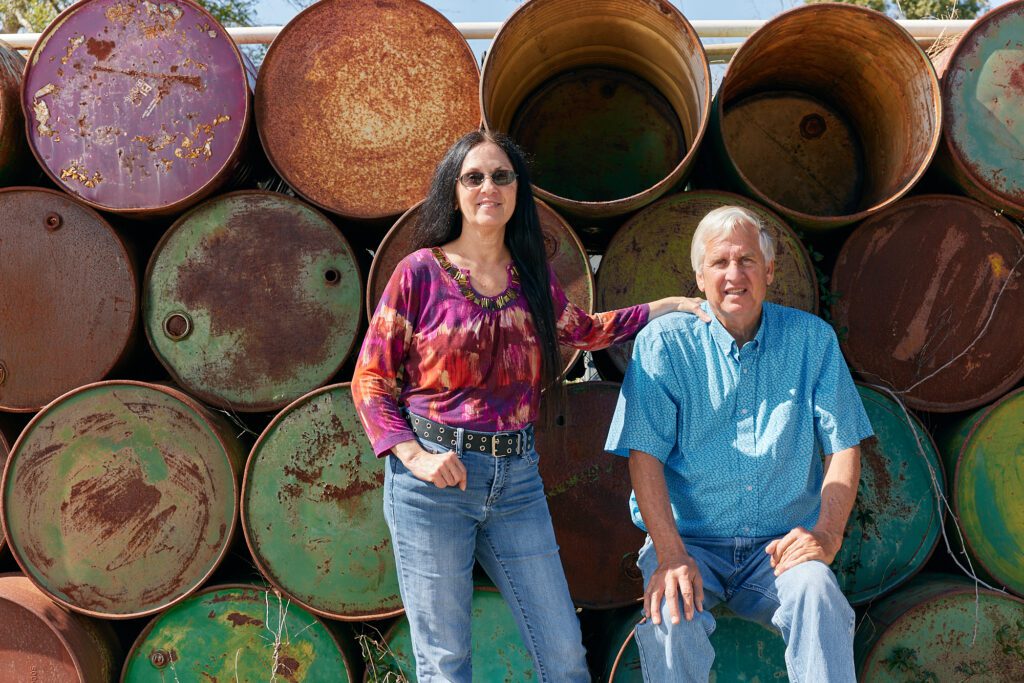
The city of Wewahitchka’s water tower stands over the Lanier’s old seafoam green homestead like a sentry. The family doesn’t live here full time anymore but the house does serve as the honey headquarters—although it feels more like a museum. Photos of family members hang on nearly every inch of the pecky cypress paneling inside and cardboard boxes filled with glass bears of honey line the baseboards. When Hurricane Michael hit, Ben stacked these boxes up against the windows to keep them from blowing in.
One glance around this home teeming with memories and it’s clear that tupelo runs deep in the Lanier family. It’s all Ben has ever known. Now 65 and with three stents in his heart, working the bees isn’t like it used to be, he says, and it’s not just because he has a few more years on him.
Making a living that depends entirely on a fragile insect and an equally temperamental tree is nothing short of crazy, Ben admits, but in recent years, it feels like everything—Mother Nature, local government, even other beekeepers—is working against him.
Weather Woes
Tupelo honey is all about timing. The white tupelo trees that the bees gather nectar from to make this rare varietal only bloom for two to three short weeks between mid-April and mid-May. Just as these clusters of small greenish white flowers begin to blossom, beekeepers move their hives to the banks of the river so the bees will collect nectar from this special source—and ideally, only this source. Then as soon as the flowers fade, they extract the honey from the hive to keep it as pure as possible.
The process relies on a lot of things working together to near perfection. During the 2019 harvest, Hurricane Michael put the trees under so much stress that they bloomed nearly five months early. Rough wind and rain can strip the trees of their flowers. A surprise cold snap can ruin the bloom, and the bees don’t like it much either. It’s a fragile field, says Brian Bertonneau, owner of Smiley Honey Co. Bertonneau purchased the bottling and sales side of Smiley Honey Co. from its founder, Donald Smiley, back in December 2012.

“It is true that over the last 10 years there have only been two or three really good years,” he says. “Then there have been several average years and several bad years.”
Even if you do manage to time it just right, Mother Nature doesn’t always play nice.
“We’ve had a number of years where there have been two weeks of outstanding weather, and the bees are going crazy, and they’re packing the honey into the hive, and everybody’s rubbing their hands with glee. And then the last week, it’ll rain seven days solid, [and] the bees will turn around and eat half of what they made,” Bertonneau says. “It can just turn on a dime.”
To account for all of the unpredictability, the Smiley Honey Co. owner sources tupelo honey from beekeepers in both Florida and Georgia so if one area is hit with calamitous weather, he can lean on the other to make up his losses. But for people like the Laniers, who handle both the apiary and the bottling aspects of the business, they’re subject to the whims of the weather.
Hard Times for Honey
Today, the forces of nature are in our favor.
“You need a beautiful, sunshiny day like today to work the bees,” Glynnis says as I hop into her white SUV. So that’s exactly what we do. It’s not quite time to move the hives down to the swamps, so they’re divvied up between different plots of land in the woods around Wewahitchka. Glynnis instructs me to pull my hair back and hands me a veiled hat designed to protect from bee stings. As I cinch the drawstring nice and tight, she points to my jacket.
“Take that black jacket off; they do not like black.”
I trade in my jacket for one of the khaki button-ups Glynnis keeps in her truck. I wouldn’t want to incite their rage. Ben and Heath don’t bother with the veils; Ben’s been stung everywhere you could possibly be stung.
“You don’t even wanna know!” Glynnis laughs.
This particular plot is nothing more than a slab of concrete with overgrown weeds eating at the edges. Wooden pallets with hives, some stacked two or three high, rim the concrete. Square dirt marks are the only evidence that there used to be more hives in this bee yard.
I’m bangin’ my head against the concrete trying to figure out what’s going on with my hives.”
— Ben Lanier
At the end of last year’s tupelo season, the Laniers had 600 hives. But in early July 2022, they started to die off in droves. Today, they’re down to about 50.
“I’m bangin’ my head against the concrete trying to figure out what’s going on with my hives,” Ben says.
One by one, Ben and Heath open up each hive to check how healthy it’s looking. As soon as the lid is off, Ben knows it’s not right. He’s expecting a balloon of bees to emerge when they open the top; instead, only one or two fly out as Ben reaches down to remove a frame, where the bees store food, raise brood and, eventually, make honey.
“That oughta be slap full of bees!” Ben huffs.
It isn’t just one virus or parasite responsible for the pervasive bee die-offs the Laniers are experiencing—and it’s not just the Laniers. Beekeepers across the United States have experienced significant colony loss. From April 2020 to April 2021, beekeepers lost an estimated 45.5 percent of their colonies, according to survey responses gathered by Bee Informed Partnership, a nonprofit that conducts research surrounding the health of U.S. honeybee colonies. The preliminary results for 2021 to 2022 show a slightly lower average loss of 39 percent. And if the Laniers’ bee yard is any indication of next year’s results, they’re shaping up to be pretty grim.
The Pest Problem
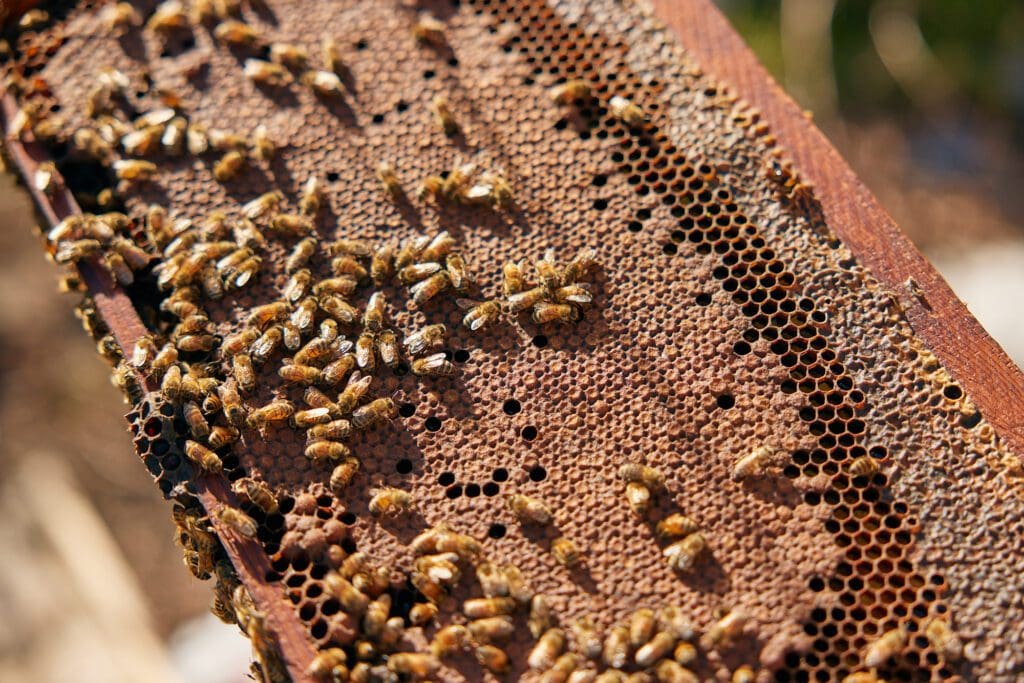
Each hive that Ben opens reveals a new enemy. The first one has a small hive beetle hiding inside, indicating a weak colony, Ben says. The beetle larvae tunnel through the hive, feeding along the way. Another has wax moth larvae inside. Much like the beetle larvae, these pests will burrow through the colony, chew into the frames and damage the honey comb.
Even his biggest hive, the one that he deems “beautiful” when he removes the lid, is housing an assassin bug. Despite its name, these pests are actually one of the less severe nuisances to honey bees. Although it will feed on bees when given the chance, it’s not usually present in large enough quantities to decimate a colony.
Ben’s excitement builds with each frame he removes from the big hive. Finally, he’s found a winner. He starts pointing out the drones, and the brood and the worker bees toting pollen on their legs. Before his enthusiasm bubbles over, he sticks his finger inside a cell of larvae to check for what’s become one of his biggest problems: the varroa mite.
The varroa mite is considered to be the most devastating pest to honeybees worldwide. These mites feed on bee larvae and pupae as well as the hemolymph of adult bees, basically their blood. Varroa mites can kill bees in their pupae stage, spread viruses and decrease the foraging ability of adult bees, meaning that even if they survive to tupelo season, they’re not going to produce the same amount of honey as a healthy hive.
Ben’s spent thousands of dollars on chemical strips that supposedly kill the varroa mite, but he says they just aren’t doing the trick. The best defense is to prevent them from infiltrating the hive at all.
That’s what Florida’s mandated apiary inspections are supposed to do: prevent the spread of honeybee pests and diseases. Beekeeping is a largely migratory business, meaning that beekeepers will drive their bees around the country to pollinate different crops—almonds in California during the winter, blueberries in Maine and Michigan during the spring and summer and cherries in Washington in early spring. All this travel can lead to the rampant spread of disease if left unchecked.
There are not enough bee inspectors to inspect all these bees. That is impossible.
— Glynnis Lanier
When a beekeeper enters the state of Florida, they need a Florida certificate of registration or a health certificate issued by the state they’re coming from, says Branden Stanford, who’s been Florida’s state apiarist since May 2022. In order to obtain a beekeeper certificate of registration in Florida, the apiary needs to have been inspected by the state within the last year. During these inspections, a state official looks for evidence of pests and diseases, primarily American Foulbrood, a rapidly spreading bacterial disease that can only be stopped by burning the hive. Even if they have a health certificate from another state, they must register by law with the Florida Department of Agriculture and Consumer Services and have their hives inspected within 30 days of arrival.
The thing is, it’s up to the beekeepers to notify the department that they’ve entered the state and need an inspection.
“It either relies on them to tell us what they’re up to or us reaching out to them and being very proactive,” Stanford says. “But with as small as we are and how many beekeepers [there are], it’s kind of hard.”
Florida has 10 apiary inspectors and two supervisors handling these inspections.
“They’re spread pretty thin because we have about 5,500 beekeepers across the state,” he says.
Stanford says that when a beekeeper notifies the department that they’ve arrived, the region’s apiary inspector will go out and inspect the hives within a week or so. The Laniers seriously doubt that.
“There are not enough bee inspectors to inspect all these bees,” Glynnis says. “That is impossible.”
Sticky Sabotage
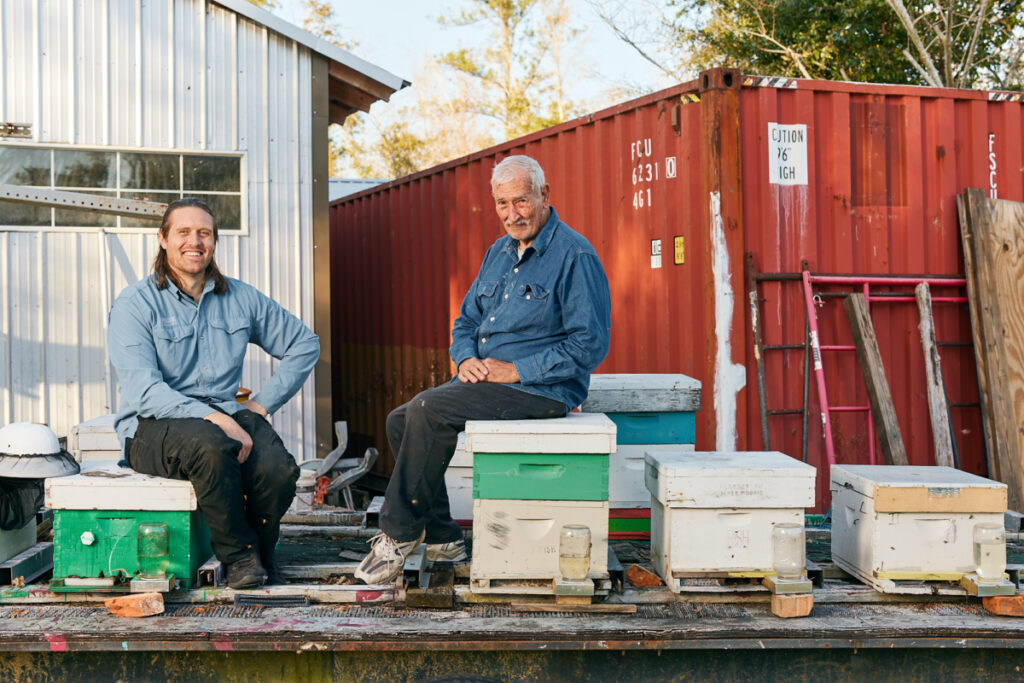
These days, Ben has to think about a whole new kind of pest, one that’s more conniving than all the others: fellow beekeepers. Tupelo honey is one of the most expensive varieties on the market—most 16-ounce bottles start around $16—because of its unique composition, flavor and rarity. And as with anything, more dollar signs often means more drama.
“We actually had somebody steal about 20 hives from here this year,” Glynnis says about the bee yard we’re standing in.
The theft seemed to be done by someone who knew their way around a beehive, she says. Some hives are made up of multiple boxes stacked on top of one another. Instead of taking the box on top, the thief went down into the bottom box and took the frames where the queen and all her brood were, then put the lid and all the other boxes back in their place. You couldn’t even tell the heart of the hive was missing, Ben says. The Laniers reported the theft to the Gulf County Sheriff’s Office but the culprit hasn’t been caught. Ben doesn’t expect them to be. Most of these thefts happen in the dead of night, so some local beekeepers, like the Rish family, have put up video surveillance on their bee yards to catch potential thieves.
Stanford, the state apiarist, agrees that this crime can be easy to pull off without detection. Like the Laniers, a lot of commercial beekeepers keep their hives on wooden pallets. With the help of a forklift, you could load up multiple pallets of hives and drive off in minutes.
Some saboteurs don’t even need to touch the hives for their dirty work; instead they’ll poison them with pesticides or herbicides.
“This one’s tricky,” Stanford says. “People claim it happens quite a bit.”
When someone reports to the state that their hive was poisoned, Stanford’s team works with Florida’s Division of Agricultural Environmental Services to test for misuse of pesticides. They’ll also check for the presence of pests and diseases that could have contributed to the death of the colony. Stanford says it can be difficult to pinpoint the exact cause of death of a hive because it’s often a combination of factors. If the colony is stressed from preexisting disease or pests, exposure to even a moderate amount of pesticides (an amount that wouldn’t be considered a “misuse of pesticides”) can kill the bees because their immune system is weak. Since becoming the state apiarist in May 2022, Stanford says he’s never had a lab result come back indicating a misuse of pesticides.
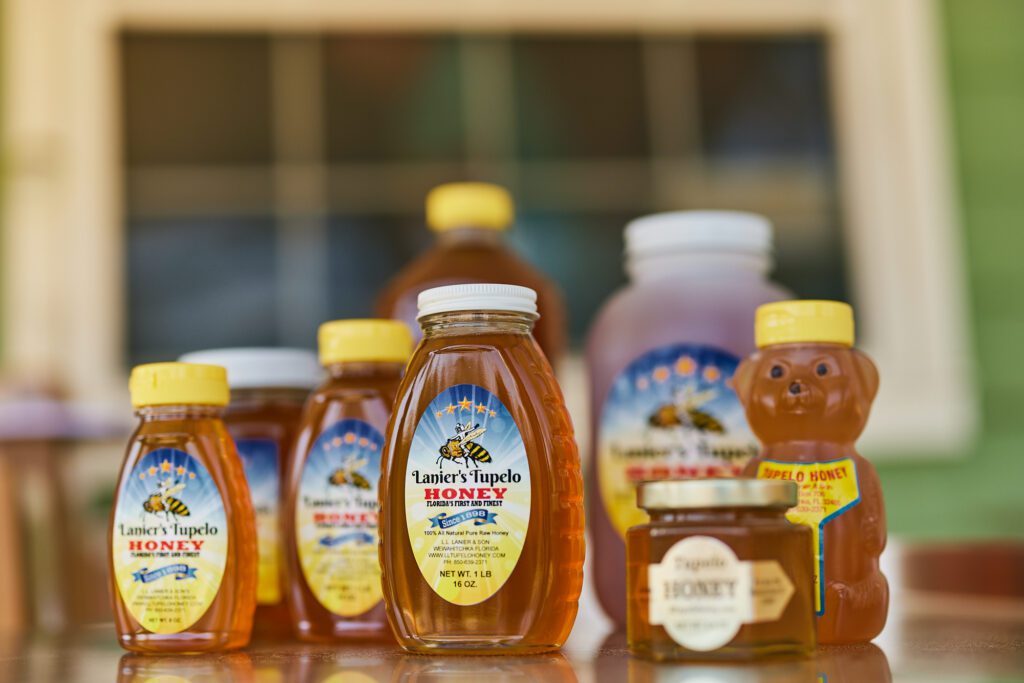
In more recent years, overcrowding in the swamps is becoming an issue for beekeepers as the tupelo craze grows. Bees typically forage within two to three miles of their hive, so the closer to the target nectar source, the better. As more and more migratory beekeepers want in on this pricey product, they’re all vying for a spot near the swamps where these trees thrive. If they’re one of the lucky ones who snag a piece of this coveted land, they’ll often stick as many hives as they can fit there.
“Because tupelo became such a popular honey and the demand has been ever increasing, beekeepers keep getting closer and closer to each other with these bee yards and then that absolutely reduces your yield,” Bertonneau says.
Just like the beekeepers are vying for the same land, the bees are all after the same nectar. On agricultural land, there are no restrictions around how many hives you can place per acre or how far away they need to be from the property line. It’s up to the beekeepers to work it out among themselves if they have crowding issues with their neighbors, and no one is too keen on getting rid of some of their hives—and in turn their honey—to make their neighbors happy.
Keeping the Buzz Ablaze
When I ask Ben if he’s thought about putting up video surveillance to protect his bee yards from theft, poison and all the other unseemly antics, he grows real quiet. Ben Lanier is rarely speechless, and this silence is heavy with something. It’s not quite defeat, but it’s definitely exhaustion.
“I like working the bees, I like doing a little bit, but I’m about ready to just let my son have this,” he says.
Ben took over the business when he was just 16 years old, and he was working the hives alongside his father as soon as he could hold a smoker. He’s devoted more than 50 years of his life to learning the language of the bees—what they like, what they don’t and how to protect them from each new pest that pops up. But he’s running out of energy. His heart can’t handle long days in the heat like it used to—and it can’t handle the drama either.
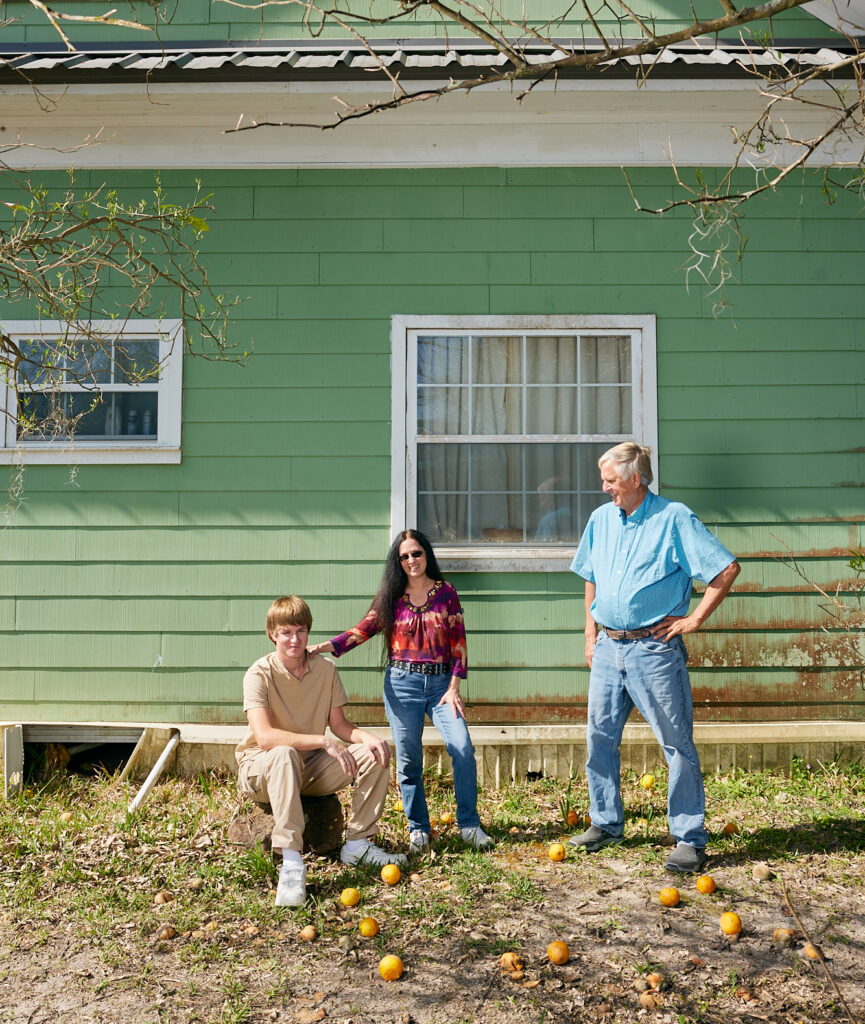
Glynnis says she’s tried to get local commissioners to address the overcrowding issue by creating new setbacks, or rules that would require beekeepers to put their hives a certain distance away from another apiary. Beekeepers used to do this on their own because it was better for everyone’s production, but that courtesy has fallen by the wayside as more and more migratory beekeepers bring their hives to the region for the tupelo season, she says. Glynnis thinks that a two-mile buffer would be sufficient, but she can’t get any traction with her local government.
“We have had no success with our commissioners,” she says. “They talk about it, and that’s the end of it.”
Glynnis is tired of wasting her breath on a commission that doesn’t seem to care about the regional rarity it plasters all over its roadway signs and social media. And Ben has no interest in the politics of it all. He just wants to work the bee yards like the old days.
“I always say he’s a real beekeeper,” Glynnis says. “Ben cares about his bees just like he would care for your child. That’s the way he’s always been.”
Once the smoker fizzles out and all the hives have been opened, we remove our veils and pile back into Glynnis’ SUV to head back to the honey house. Just as I’m about to swing my door shut, Ben runs over, hollering.
“Hey, Jessica! You see! You see!”
I had asked him earlier why he sticks with a field that’s so unpredictable, so messy. The answer has finally hit him.
“Do you see how excited I am when I see a good hive?” he says. “I’m just like a kid again.”





